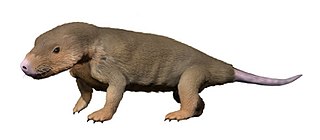 W
WAbdalodon is an extinct genus of late Permian cynodonts, known by its only species A. diastematicus. Abdalodon together with the genus Charassognathus, form the clade Charassognathidae. This clade represents the earliest known cynodonts, and is the first known radiation of Permian cynodonts.
 W
WAgaresuchus is an extinct genus of allodaposuchid once known as "Allodaposuchus" subjuniperus. It was recovered from the late-Maastrichtian Conquès Formation, part of the Tremp Group, in the province of Huesca, Spain. It was found in the Amor-3 layer.
 W
WAlcovasaurus is a genus of herbivorous thyreophoran dinosaur that lived in the Late Jurassic. It was found in the Morrison Formation of Natrona County, Wyoming, United States. The type species is Stegosaurus longispinus, and the combinatio nova is Alcovasaurus longispinus.
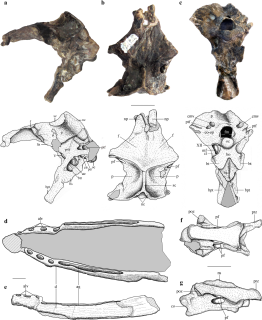 W
WAllkaruen is a genus of "rhamphorhynchoid" pterosaur from the Early-to-Middle Jurassic Cañadon Asfalto Formation in Argentina. It contains a single species, A. koi.
 W
WAngelarctocyon is an extinct genus of Amphicyonidae, which belongs to the order Carnivora.
 W
WApatoraptor is a genus of caenagnathid dinosaur which contains a single species, A. pennatus. The only known specimen was discovered in the Campanian-age Horseshoe Canyon Formation of Alberta.
 W
WAphaenogaster dlusskyana is an extinct species of ant in the subfamily Myrmicinae known from a single Middle Eocene fossil found in amber on Sakhalin. At the time of description A. dlusskyana was one of eight ant species known from Sakhalin fossil.
 W
WAquilonifer spinosus is an extinct species of arthropod from the Silurian period. It is known from a single fossil specimen found in the Wenlock Series Lagerstätte of Herefordshire, England, in rocks about 430 million years old. The 1 cm long specimen is a stem-group mandibulate, not directly related to any living species. The many-legged, eyeless adult has ten unusual tethered appendages, interpreted as juveniles attached to the parent, in a unique form and previously unknown brooding behaviour.
 W
WArktocara is an extinct genus of river dolphin from the Oligocene epoch of Alaska, containing one species, A. yakataga. Having been discovered in 25-million-year-old strata near the 60th parallel north, it is perhaps the oldest known crown toothed whale and the northmost river dolphin discovered. It was a member of the now-extinct family Allodelphinidae, along with the genera Allodelphis, Goedertius, Ninjadelphis, and Zarhinocetus. It measured approximately 2.26 or 2.28 meters, comparable to its closest living relative, the South Asian river dolphin, which measures 2.4 meters (7.9 ft). However, the animal probably had an elongated beak and neck, so it may have been longer. The animal is known only from a partially preserved skull. Its ecology may have been similar to the modern day Dall's porpoise, and it may have competed with contemporaneous delphinoids. Its remains were found in the Poul Creek Formation, which has also yielded several mollusk species.
 W
WAustroposeidon is an extinct genus of titanosaurian sauropod dinosaur from the Late Cretaceous Presidente Prudente Formation of Brazil. It contains one species, Austroposeidon magnificus.
 W
WAymberedactylus is a genus of tapejarid pterosaur from the Early Cretaceous Crato Formation of Brazil. It contains a single species, A. cearensis.
 W
WBuriolestes is a genus of early sauropodomorph dinosaurs from the Late Triassic Santa Maria Formation of the Paraná Basin in southern Brazil. It contains a single species, B. schultzi, named in 2016. The type specimen was found alongside a specimen of the lagerpetid dinosauromorph Ixalerpeton.
 W
WCamelomecia is an extinct genus of stem-group ants not placed into any Formicidae subfamily. Fossils of the single known species, Camelomecia janovitzi, are known from the Middle Cretaceous of Asia. The genus is one of several ants described from Middle Cretaceous ambers of Myanmar.
 W
WCeratomyrmex is an extinct genus of ant in the Formicidae subfamily Haidomyrmecinae, and is one of only nine genera placed in the subfamily Haidomyrmecinae. The genus contains a single described species Ceratomyrmex ellenbergeri and is known from several Late Cretaceous fossils which have been found in Asia.
 W
WDracoraptor is a genus of neotheropod dinosaur that lived during the Hettangian stage of the Early Jurassic Period of what is now Wales, sometime between 201 to 199 million years ago. It was discovered in 2014 at the Blue Lias Formation of the United Kingdom, and named in 2016 by British palaeontologist David Martill and colleagues, with the type species being Dracoraptor hanigani.
 W
WEotrachodon orientalis is a species of hadrosaurid that was described in 2016. The holotype was found in the Mooreville Chalk Formation in Alabama in 2007 and includes a well-preserved skull and partial skeleton, making it a rare find among dinosaurs of Appalachia. Another primitive hadrosaur, Lophorhothon, is also known from the same formation, although Eotrachodon lived a few million years prior. A phylogenetic study has found Eotrachodon to be the sister taxon to the hadrosaurid subfamilies Lambeosaurinae and Saurolophinae. This, along with the other Appalachian hadrosaur Hadrosaurus and possibly Lophorhothon, Claosaurus and both species of Hypsibema, suggests that Appalachia was the ancestral area of Hadrosauridae.
 W
WForaminacephale is a genus of pachycephalosaurid dinosaur from Late Cretaceous deposits of Canada.
 W
WFukuivenator is an extinct genus of coelurosaurian theropod dinosaur from the Early Cretaceous of Japan.
 W
WGerontoformica is an extinct genus of stem-group ants. The genus contains thirteen described species known from Late Cretaceous fossils found in Asia and Europe. The species were described between 2004 and 2016, with a number of the species formerly being placed into the junior synonym genus Sphecomyrmodes.
 W
WGoedertius is an extinct genus of river dolphin from the early Miocene (Burdigalian) Nye Formation of Oregon.
 W
WGustafsonia is an extinct genus of carnivoran belonging to the family Amphicyonidae. The type species, Gustafsonia cognita, was described in 1986 by Eric Paul Gustafson, who originally interpreted it as a miacid and named it Miacis cognitus. It was subsequently considered to be the only species of the diverse genus Miacis that belonged to the crown-group Carnivora, within the Caniformia, and it was ultimately assigned to the family Amphicyonidae. The type specimen or holotype was discovered in Reeve's bonebed, western Texas, in the Chambers Tuff Formation in 1986. The University of Texas holds this specimen. It is the only confirmed fossil of this species.
 W
WIdmonarachne is an extinct genus of arachnids, containing one species, Idmonarachne brasieri. It is related to uraraneids and spiders.
 W
WIncakujira is an extinct genus of rorqual from the Late Miocene Pisco Formation in western Peru.
 W
WKaikaifilu is a genus of tylosaurine mosasaur from the Late Cretaceous part of the Lopez de Bertodano Formation of Antarctica, just before the Cretaceous–Paleogene extinction event. It is among the largest members of the tylosaurines, a group of marine lizards that lived during the Cretaceous, and the only really large Antarctic tylosaurine.
 W
WMachairoceratops is an extinct genus of centrosaurine ceratopsian dinosaur known from the Late Cretaceous Wahweap Formation of Grand Staircase-Escalante National Monument, southern Utah, United States.
 W
WMaofelis cantonensis is an extinct basal nimravid from Late Eocene-aged Youganwo Formation of Maoming Basin, Guangdong Province, China.
 W
WMegachasma alisonae is an extinct species of megamouth shark that lived during the Eocene. It is the oldest fossil record of a megamouth shark. The type fossil was recovered from the Søvind Marl Formation in Denmark and consists of a single tooth. Based on comparison with the teeth of the recent megamouth species, the length of the animal has been estimated at 1.3–3.5 m (4.3–11.5 ft).
 W
WMegalolamna is an extinct genus of lamniform shark that belongs to the family Otodontidae. Its name comes from the similarity of its teeth to those of the extant shark genus Lamna. It is known from the early Miocene Chilcatay Formation of Peru, Oi and O'oshimojo Formations of Japan, and the Jewett Sand Formation of California and Pungo River Formation, North Carolina in the United States, implying a cosmopolitan distribution. It is considered to be the sister genus of Otodus. The study of Megalolamna's taxonomic relationships also demonstrates the possibility that Otodus needs to include the species sometimes assigned to Carcharocles in order to be monophyletic.
 W
WMeroktenos is a genus of basal sauropodomorph dinosaur that lived during the Late Triassic of Lesotho.
 W
WMicroleo attenboroughi is a very small species of the Thylacoleonidae family from the Early Miocene of Australia, living in the wet forest that dominated Riversleigh about 18 million years ago. The genus Microleo is currently known from a broken palate, two pieces of jaw, containing some teeth and roots that correspond to those found in other species of thylacoleonids. The shape and structure of the blade-like P3 tooth, a premolar, distinguished the species as a new genus. It was found in Early Miocene-aged deposits of the Riversleigh fossil site in Queensland, regarded as one of the most significant palaeontological sites yet discovered, and named for the naturalist David Attenborough in appreciation of his support for its heritage listing. The anatomy of Microleo suggests the genus is basal to all the known thylacoleonids, known as the marsupial lions, although its relative size prompted a discover to describe it as the "feisty" kitten of the family.
 W
WMithridatocetus is a genus of cetotheriid mysticete in the subfamily Cetotheriinae. Known specimens have been found in marine deposits in Crimea, Ukraine, and the Russian Caucasus.
 W
WMurusraptor is a genus of carnivorous megaraptoran theropod dinosaur from the Sierra Barrosa Formation, part of the Neuquén Group of Patagonia, in Argentina, South America. It is known from a single specimen that consists of a partial skull, ribs, partial pelvis, leg and other assorted skeletal elements.
 W
WNotocolossus is a genus of titanosaurian sauropod dinosaur from late Cretaceous strata of Mendoza Province, Argentina.
 W
WOzimek is a genus of sharovipterygid protorosaur, a type of gliding Triassic archosauromorph reptile from Poland closely related to the Kyrgyzstani Sharovipteryx. It contains one species, O. volans, named in 2016 by Dzik and Sulej.
 W
WProtoalligator is an extinct genus of crocodilian which lived during the Paleocene. It is considered to be an alligatoroid, but its exact phylogeny is uncertain.
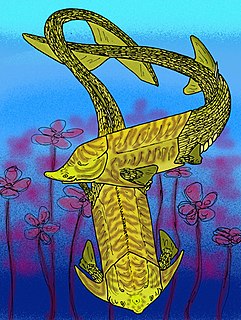 W
WQilinyu rostrata is a "maxillate" placoderm from the late Ludlow epoch of Qujing, Yunnan, 419 million years ago.
 W
WRativates is a genus of ornithomimid theropod dinosaur from the Dinosaur Park Formation of Alberta. The type species is Rativates evadens.
 W
WRogerella is a small pouch-shaped boring with a slit-like aperture currently produced by acrothoracican barnacles. These crustaceans extrude their legs upwards through the opening for filter-feeding. They are known in the fossil record as borings in carbonate substrates from the Devonian to the Recent.
 W
WSarmientosaurus is a genus of titanosaurian sauropod dinosaur belonging to the Titanosauria. It lived in what is now South America, specifically Argentina, during the Upper Cretaceous Period about 95 million years ago. The type species is Sarmientosaurus musacchioi.
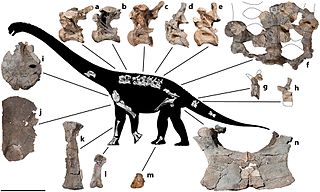 W
WSavannasaurus is a genus of titanosaurian sauropod dinosaur from the Late Cretaceous Winton Formation of Queensland, Australia, containing one species, Savannasaurus elliottorum, named in 2016 by Poropat et al. The only known specimen was originally nicknamed "Wade". The holotype is held on display at the Australian Age of Dinosaurs museum.
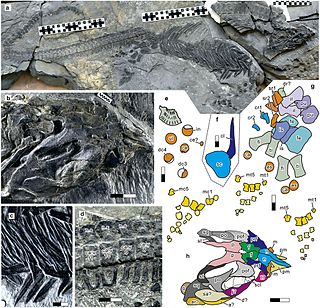 W
WSclerocormus is an extinct genus of ichthyosauriform from the early Triassic period. The fossil was discovered in the central Anhui Province, China. It is currently only known from one specimen, however the fossil is mostly complete and as such further increases our understanding of the early evolution of ichthyosaurs.
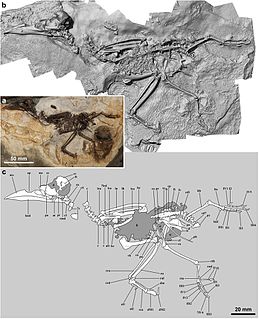 W
WSeptencoracias is an extinct genus of bird related to modern rollers and other Coraciiformes such as kingfishers, bee-eaters, motmots, and todies. It contains one species, Septencoracias morsensis. It was found in the Fur Formation of Denmark, dating back to the Ypresian of the Lower Eocene Epoch, about 54 million years ago. Septencoracias is one of the earliest known members of Coraciiformes, lending insight into the earliest radiation of this group.
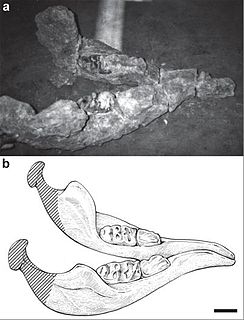 W
WSinomammut is a proboscidean found in the Miocene of China. It was known from a single, fragmentary, mandible found in the 1990s. However, most of the specimen has been lost, leaving only the right ramus and an in-situ photograph of the mandible. The mandible was originally thought a gompothere closely related to Sinomastodon, but an analysis revealed it to actually be a mammutid that was a sister group to the well-known mastodon. It can be distinguished from the mastodon by its lack of lower tusks.
 W
WSpiclypeus is an extinct genus of chasmosaurine ceratopsian dinosaur known from the Late Cretaceous Judith River Formation of Montana, United States.
 W
WTeyujagua is an extinct genus of small, probably semi-aquatic archosauromorph reptile that lived in Brazil during the Early Triassic period. The genus contains the type and only known species, T. paradoxa. It is known from a well-preserved skull, and probably resembled a crocodile in appearance. It was an intermediary between the primitive archosauromorphs and the more advanced Archosauriformes, revealing the mosaic evolution of how the key features of the archosauriform skull were acquired. Teyujagua also provides additional support for a two-phase model of archosauriform radiation, with an initial diversification in the Permian followed by a second adaptive radiation in the Early Triassic.
 W
WTimurlengia is an extinct genus of tyrannosauroid theropod dinosaur found in Uzbekistan, in the Bissekty Formation in the Kyzylkum Desert, hailing from the Turonian age of the early Late Cretaceous. The type species is Timurlengia euotica.
 W
WTingmiatornis is a genus of flighted and possibly diving ornithurine bird from the High Arctic of Canada. The genus contains a single species, T. arctica, described in 2016, which lived during the Turonian epoch of the Cretaceous.
 W
WTongtianlong is a genus of oviraptorid theropod dinosaurs that lived in the late Maastrichtian epoch of the late Cretaceous period. It contains one species, T. limosus.
 W
WViavenator is a genus of carnivorous abelisaurid theropod dinosaur discovered in Argentina's Bajo de la Carpa Formation. It coexisted with the megaraptoran Tratayenia rosalesi.
 W
WVivaron is a genus of rauisuchid known from the Late Triassic Chinle Formation in New Mexico. It is the second rauisuchid known from the southwestern United States, and it highlights the wide biogeographic range similar rauisuchid taxa occupied during the Late Triassic across Pangaea, despite the varied faunal assemblages at different latitudes.
 W
WWahlisaurus is an extinct genus of leptonectid ichthyosaur. The holotype was found in the Scunthorpe Mudstone in Nottinghamshire in 1951 and described for the first time only in 2016 by Dean Lomax. The type species is Wahlisaurus massare.
 W
WWiehenvenator is a genus of predatory megalosaurid theropod dinosaur from the Middle Jurassic (Callovian) of Germany.